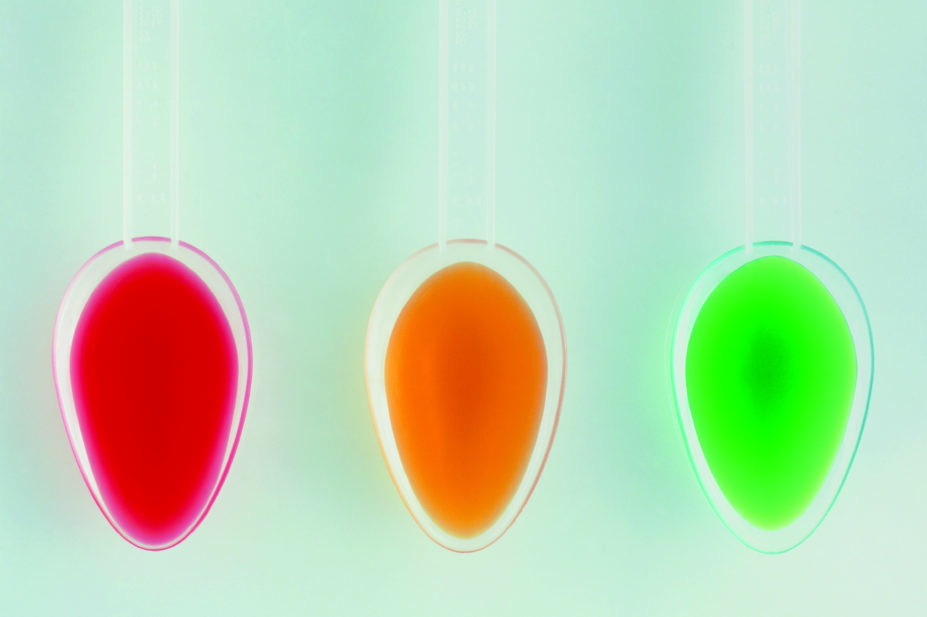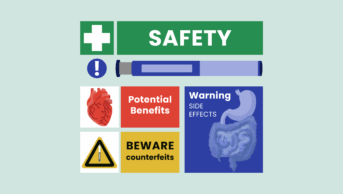
Gustoimages / Science Photo Library
Oral liquid formulations, such as solutions and suspensions, are commonly given to young children because they are easy to swallow. However, many liquid formulations have not been studied extensively, or authorised for paediatric use. This has resulted in the widespread routine clinical use of unlicensed medicines, and the use of adult medicines outside of their licence, usually referred to as ‘off-label’ use, in children.
Excipients are essential components of drug formulations, facilitating their manufacture and storage. However, the excipients used in adult formulations may not be appropriate for paediatric patients, and therefore have the potential to lead to adverse effects.
Children may not be able to metabolise or eliminate an excipient in the same way as an adult, because of their physiological and developmental differences[1]
. Pre-term, low-birth neonates and infants are particularly vulnerable owing to the immaturity of their hepatic and renal systems for metabolism and elimination[1]
.
Manufacturers’ summaries of product characteristics (SPCs) are useful for identifying the excipients in a particular medicine. SPCs can be accessed via the electronic medicines compendium. Manufacturers’ medical information departments are also very helpful for determining the specific amounts of excipients present in formulations.
This article aims to raise awareness of ‘problem’ excipients that can cause adverse reactions in children and provide information for pharmacists and healthcare professionals to determine whether a liquid formulation is suitable.
Common ‘problem’ excipients
The potential issues associated with excipients in oral, topical and intravenous formulations are highlighted in Table 1. Please note that the list is not exhaustive and that exclusion does not indicate safety.
| Table 1: Examples of ‘problem’ excipients, their role in formulations and potential adverse effect(s) | ||
|---|---|---|
| Excipient | Role in formulation | Adverse effect(s) |
| Propylene glycol | Solvent | Central nervous system (CNS) effects, especially in neonates and children under four years[2] |
| Ethanol | Solvent | Intoxication[2] ,[3] |
| Polyoxyl castor oil | Vehicle | Severe anaphylactoid reactions[4] |
| Polysorbate 80 | Solubilising agent | E-Ferol syndrome[1] , hypersensitivity reactions[5] |
| Benzyl alcohol | Preservative | ‘Gasping syndrome’ in neonates[6] |
| Benzoic acid | Preservative | Jaundice in neonates[2] ,[7] |
| Parabens (methyl-, ethyl- and propyl-hydroxybenzoates) | Preservative | Suggestion of oestrogenic activity with potential reproductive effects (with propylparaben)[3] ,[8] , hypersensitivity reactions[9] , hyperbilirubinaemia in neonates[10] |
| Benzalkonium chloride | Preservative | Bronchospasm from anti-asthmatic drugs[11] ,[12] |
| Sodium metasulfites | Antioxidant | Wheezing, dyspnoea and chest tightness in asthmatic children[12] |
| Sorbitol | Sweetener | Osmotic diarrhoea and gastrointestinal discomfort[13] ,[14] |
| Glucose and sucrose | Sweetener | Obesity and tooth decay[1] |
| Saccharin | Artificial sweetener | Hypersensitivity and photosensitivity reactions[9] ,[15] |
| Aspartame | Artifical sweetener | A source of phenylalanine that should be avoided in patients with phenylketonuria [1] ,[2] |
| Colourants | Colouring agents | Sensitivity reactions and hyperactive behaviour in children[9] |
Propylene glycol
The solvent propylene glycol (PG) is used in a variety of oral liquid, topical and injectable medicines[2]
. Accumulation of PG can occur in neonates and young children as they cannot adequately metabolise and eliminate the excipient[4]
,[16]
. This reduced metabolism and elimination can lead to depression of the central nervous system (CNS)[2]
. Despite clinical data demonstrating that higher PG load may be safely administered to children >4 years and adults, a more cautious approach is still recommended for children under 5 years because of a lack of clinical data[17]
. Table 2 provides more detail on the European Medicines Agency (EMA) proposed safety limits for PG in children. Box 1 describes how to calculate the quantity of PG in a pharmaceutical product (in % w/v), including a worked example.
| Table 2: European Medicines Agency proposed safety limits for propylene glycol [17] | |||
|---|---|---|---|
| Neonates up to 28 days (or 44 weeks post-menstrual age for pre-terms) | Children aged 1 month–4 years | Children aged 5–17 years | |
| Safety limits (maximum daily dose) | 1mg/kg | 50mg/kg | 500mg/kg |
Box 1: Calculating the quantity of propylene glycol (PG) in a pharmaceutical product (in % w/v), with a worked example
Some manufacturers state the amount of PG in ml/5ml of product. The concentration in % v/v can be converted to % w/v using the specific gravity of PG, which is 1.036 (i.e. 1ml weighs 1.036g)[18]
.
Calculation example
Amiloride 5mg/5ml sugar-free oral solution (Rosemont Pharmaceuticals) contains 0.1ml PG per 5ml of solution[18]
= 2% v/v concentration. Using the specific gravity of PG, a concentration of 2% v/v corresponds to 2.07% w/v (2ml/100ml x 1.036 = 2.07g/100ml).
The dose of amiloride for a neonate is 100–200µg/kg twice daily[4]
.
Using the lowest dose, a neonate weighing 3.5kg would receive 350µg twice daily (i.e. 700µg per day).
There is 700µg in 0.7ml of the oral solution.
This neonate can therefore safely receive up to 3.5mg of PG per day[17]
.
With a PG concentration of 2.07% w/v, there is 2,070mg PG in 100ml of oral solution. In 0.7ml of oral solution, there is 14.49mg PG. This is above the proposed safety limit for this neonate.
Ethanol
Another solvent, ethanol, is widely used in oral liquid formulations. Use in children is associated with risk of acute intoxication with accidental overdose and chronic toxicity with long-term use[2]
. Children, especially those aged under six years, are more vulnerable to the effects of alcohol, which may include drowsiness, behavioural changes, and impaired ability to concentrate and participate in school activities[19]
. Commonly used liquid formulations containing ethanol include ranitidine, phenobarbitone, furosemide and some morphine preparations[20]
.
In January 2014, the EMA proposed the inclusion of more detailed information on alcohol content in patient information leaflets (PILs) as well as alcohol content thresholds for different age groups in a draft for the guideline on ‘Excipients in the label and package leaflet of medicinal products for human use’[19]
,[21]
. Table 3 provides more detail on EMA proposed safety thresholds for ethanol in children aged ≤12 years. Box 2 describes how to calculate the quantity of ethanol in a pharmaceutical product (in % w/v), with a worked example.
| Table 3: European Medicines Agency (EMA) proposed safety thresholds for ethanol in children ≤12 years of age [19] | ||
|---|---|---|
| Children aged <6 years | Children aged 6–12 years | |
| EMA proposed ethanol thresholds in paediatric population | Blood-alcohol concentration should not exceed 1mg/100ml (a dose of 6mg/kg) | Blood-alcohol concentration should not exceed 12.5mg/100ml (a dose of 75mg/kg) |
Box 2: Calculating the quantity of ethanol in a pharmaceutical product (in % w/v), with a worked example
In the UK, information on ethanol content of a medicine can be found in the patient information leaflet (PIL) or the summary of product characteristics (SPC). The concentration in % v/v can be converted to % w/v using the specific gravity of ethanol (alcohol), which is 0.789 (0.8 can be used as an approximation)[19]
.
Calculation example
Phenobarbital Elixir BP (15mg/5ml) contains 38% v/v ethanol[22]
. Using the specific gravity of ethanol, this corresponds to a concentration of around 30.4% w/v.
The maintenance dose of phenobarbital is 2.5–4 mg/kg, once or twice a day for epilepsy in children aged 1 month–11 years[4]
. Using the lowest dose, a child aged 3 years weighing 14kg would receive 35mg daily (11.7ml of Phenobarbital Elixir)[4]
.
This 3-year-old child can receive up to 84mg of ethanol per dose[19]
.
With an ethanol concentration of 30.4% w/v, there is 30.4g of ethanol in 100ml of elixir. In 11.7ml of elixir, there is 3.55g of ethanol. This is far above the proposed safety threshold.
An unlicensed 50mg/5ml alcohol-free phenobarbital suspension is available and should be prescribed and supplied in this instance[23]
.
Sorbitol
The sugar alcohol sorbitol is commonly used as a vehicle and stabiliser in oral liquid formulations, in addition to its role as a sweetener[13]
. Preparations containing sugar alcohols are marketed as ‘sugar-free’ since they do not cause dental caries[4]
. As they are absorbed more slowly than conventional sugars, sugar alcohols are considered suitable for diabetic patients[13]
. Common adverse effects associated with sorbitol include osmotic diarrhoea and gastrointestinal discomfort[13]
,[14]
. Limited data are available on the relevant thresholds of polyols (e.g. sorbitol, mannitol) in children[24]
, although an oral dose of greater than 140mg/kg/day may result in gastrointestinal symptoms[14]
. Sorbitol is metabolised to fructose and is, therefore, unsuitable for patients with hereditary fructose intolerance[1]
. Box 3 describes how to calculate the amount of sorbitol in an oral suspension.
Box 3: Calculating the amount of sorbitol in an oral suspension
Amoxicillin 125mg/5ml oral suspension sugar-free BP (Kent Pharmaceuticals) contains 800mg sorbitol per 5ml[25]
.
A patient aged 1 year (weight 9kg) prescribed a 250mg three times daily dose[4]
will be receiving 4.8g (533.3mg/kg) of sorbitol per day.
Artificial sweeteners
Aspartame and saccharin are artificial sweeteners that are low-calorie or calorie-free; non-cariogenic; and, within the acceptable daily intake (ADI), considered safe for consumption by diabetic patients[26]
. ADIs for the general population are 40mg/kg/day and 5mg/kg/day for aspartame and saccharin, respectively[27]
,[28]
. They are used to increase palatability and to mask unpleasant taste[1]
. The evidence-base shows that artificial sweeteners are considered safe to consume up to the ADI in the general population, with the exception of foods for infants and young children (aged <3 years)[29]
. Despite being prohibited by the European Union in foods for children aged <3 years, artificial sweeteners are present in a number of medicines licensed for these age groups including amoxicillin 125/31 sugar-free suspension BP, Epilim Syrup, Nystatin Oral Suspension BP and prednisolone 5mg soluble tablets[20]
.
Colouring agents
Although the use of artificial colours in foods for children aged <3 years is prohibited, this law does not apply to medicines[29]
. Colouring agents are used in medicinal preparations to improve acceptability to patients, to aid identification and prevent counterfeiting[9]
. They are also used to increase the stability of light-sensitive drugs[9]
. They are not recommended to be given to children because the use of many colouring agents, mainly synthetic dyes, have been associated with hypersensitivity and other adverse reactions in these patients[1]
. Their use in paediatric preparations must be justified in terms of the necessity to colour the preparation and the selection of a particular colouring agent[24]
.
Manufactured specials
Unlicensed medicines that do not have a UK or European marketing authorisation are often categorised as specials. They are produced and distributed to meet the needs of an individual patient. A special should not be supplied when an equivalent licensed medicinal product can meet the specific needs of the patient[30]
,[31]
.
Specials are sometimes prescribed for children given the lower doses compared with the usual adult dose and the lack of licensed products for use in this population. They have not been assessed by the regulatory authority (EMA or the Medicines and Healthcare products Regulatory Agency [MHRA]) for safety, quality and efficacy in the same way as a licensed medicine. They do not have SPCs and PILs may not be readily available[30]
. Specials do not come in standard concentrations, which can lead to confusion and error, especially when doses are prescribed in millilitres rather than milligrams.
There are occasions when specials are the most appropriate option for a patient’s needs. However, pharmacists have a professional responsibility to minimise the risks for patients when using a special. Box 4 outlines key points that pharmacists and healthcare professionals should consider regarding specials.
Box 4: Key practice points for using specials
- Use a licensed product within the terms of its licence as first choice, or ‘off-label’ as second choice, before considering obtaining an unlicensed medicine or special;
- Order the same special from the same supplier to try to minimise product variation and patient or carer confusion;
- Check whether the excipients are suitable for the individual patient.
Supporting practice
Manufacturers’ SPCs are useful for identifying the excipients in a particular medicine but amounts are rarely specified. Clear safety limits and quantitative information on problem excipients in children are needed to aid pharmacists and healthcare professionals in medicine selection for these patients. This is especially important in neonates and young children and when patients are taking multiple liquid medications. Exposure to these excipients should be minimised as much as possible, but a medicine containing a problem excipient may be indicated after a careful risk–benefit assessment.
Useful resources
Author disclosure:
Sara Arthur and Anna Burgess also provide the information support service to the Neonatal and Paediatric Pharmacists Group (NPPG), a Royal Pharmaceutical Society Affiliated Partner.
Reading this article counts towards your CPD
You can use the following forms to record your learning and action points from this article from Pharmaceutical Journal Publications.
Your CPD module results are stored against your account here at The Pharmaceutical Journal. You must be registered and logged into the site to do this. To review your module results, go to the ‘My Account’ tab and then ‘My CPD’.
Any training, learning or development activities that you undertake for CPD can also be recorded as evidence as part of your RPS Faculty practice-based portfolio when preparing for Faculty membership. To start your RPS Faculty journey today, access the portfolio and tools at www.rpharms.com/Faculty
If your learning was planned in advance, please click:
If your learning was spontaneous, please click:
References
[1] Tuleu C. Paediatric formulations in practice. In: Costello I, Long PF, Wong IK et al. (ed) Paediatr Drug Handl London: Pharmaceutical Press; 2007;43–74.
[2] European Medicines Agency. Committee for Medicinal Products for Human Use (CHMP): Reflection paper: formulations of choice for the paediatric population 2006. Available at: http://www.ema.europa.eu/docs/en_GB/document_library/Scientific_guideline/2009/09/WC500003782.pdf (accessed July 2017)
[3] Graham S and Turner M. European study of neonatal exposure to excipients (ESNEE). Infant 2011;7(6):196–199. Available at: http://www.infantgrapevine.co.uk/pdf/inf_042_ien.pdf (accessed July 2017)
[4] Paediatric Formulary Committee. BNF for Children [Online]. London: BMJ Group, Pharmaceutical Press and RCPCH Publications; 2017. Available at: https://bnfc.nice.org.uk/ (accessed July 2017)
[5] TOXNET. Polysorbate 80. Hazardous Substances Data Bank. Available at: https://toxnet.nlm.nih.gov/cgi-bin/sis/search2/f?./temp/~TiTW4z:2 (accessed July 2017)
[6] European Medicines Agency. Committee for Medicinal Products for Human Use (CHMP): Questions and answers on Benzyl alcohol in the context of the revision of the guideline on ‘Excipients in the label and package leaflet of medical products for human use’ (CPMP/463/00) Draft; Feb 2014. Available at: http://www.ema.europa.eu/docs/en_GB/document_library/Scientific_guideline/2014/02/WC500162032.pdf (accessed July 2017)
[7] European Medicines Agency. Committee for Medicinal Products for Human Use (CHMP): Questions and answers on Benzoic acid and benzoates in the context of the revision of the guideline on ‘Excipients in the label and package leaflet of medical products for human use’ (CPMP/463/00) Draft; Feb 2014. Available at: http://www.ema.europa.eu/docs/en_GB/document_library/Scientific_guideline/2014/02/WC500162031.pdf (accessed July 2017)
[8] European Medicines Agency. Reflection paper on the use of methyl- and propylparaben as excipients in human medicinal products for human use; Oct 2015. Available at: http://www.ema.europa.eu/docs/en_GB/document_library/Scientific_guideline/2015/11/WC500196733.pdf (accessed July 2017)
[9] Pharmaceutical Excipients. In: Sweetman S (ed). Martindale: The Complete Drug Reference London: The Royal Pharmaceutical Society. [Online] Truven Health Analytics, Greenwood Village, Colorado, USA. Available at: http://www.micromedexsolutions.com (accessed July 2017)
[10] Turner MA, Duncan JC, Shah U et al. Risk assessment of neonatal excipient exposure: lessons from food safety and other areas. Adv Drug Deliv Rev 2014;73: 89–101. doi: 10.1016/j.addr.2013.11.003
[11] European Medicines Agency. Committee for Medicinal Products for Human Use (CHMP): Questions and answers on benzalkonium chloride in the context of the revision of the guideline on ‘Excipients in the label and package leaflet of medical products for human use’ (CPMP/463/00) Draft; Jun 2014. Available at: http://www.ema.europa.eu/docs/en_GB/document_library/Scientific_guideline/2014/06/WC500169459.pdf (accessed July 2017)
[12] American Academy for Paediatrics: Committee on Drugs. ‘Inactive’ ingredients in pharmaceutical products update (Subject review). Pediatrics 1997;99(2):268–278. Available at: http://pediatrics.aappublications.org/content/99/2/268.long (accessed July 2017)
[13] Nahata MC. Safety of “inert” additives or excipients in paediatric medicines. Arch Dis Child Fetal Neonat Ed 2009;94(6):F392–393. doi: 10.1136/adc.2009.160192
[14] European Medicines Agency. Committee for Medicinal Products for Human Use (CHMP): Information in the package leaflet for fructose and sorbitol in the context of the revision of the guideline on ‘Excipients in the label and package leaflet of medicinal products for human use’ (CPMP/463/00 Rev. 1) Draft; April 2016. Available at: http://www.ema.europa.eu/docs/en_GB/document_library/Scientific_guideline/2016/05/WC500206001.pdf (accessed July 2017)
[15] Fabiano V, Mameli C and Zuccotti GV. Paediatric pharmacology: remember the excipients. Pharmacol Res 2011;63(5):362–365. doi: 10.1016/j.phrs.2011.01.006
[16] European Medicines Agency. Committee for Medicinal Products for Human Use (CHMP): Questions and answers on propylene glycol and esters in the context of the revision of the guideline on ‘Excipients in the label and package leaflet of medical products for human use’ (CPMP/463/00) Draft; Nov 2014. Available at: http://www.ema.europa.eu/docs/en_GB/document_library/Scientific_guideline/2014/12/WC500177945.pdf (accessed July 2017)
[17] European Medicines Agency. Background review for the excipient propylene glycol in the context of the revision of the guideline on ‘Excipients in the label and package leaflet of medical products for human use’ (CPMP/463/00 Rev. 1) Draft; Nov 2014. Available at: http://www.ema.europa.eu/docs/en_GB/document_library/Report/2014/12/WC500177937.pdf (accessed July 2017)
[18] Rosemont®. Medical Information. Personal communication. 24 May 2017.
[19] European Medicines Agency. Committee for Medicinal Products for Human Use (CHMP): Questions and answers on ethanol in the context of the revision of the guideline on ‘Excipients in the label and package leaflet of medical products for human use’ (CPMP/463/00) Draft; Jan 2014. Available at: http://www.ema.europa.eu/docs/en_GB/document_library/Scientific_guideline/2014/02/WC500162033.pdf (accessed July 2017)
[20] Electronic Medicines Compendium (2017) [Database on the Internet]. Datapharm Communications Ltd. Available at: http://www.medicines.org.uk/emc/ (accessed July 2017)
[21] Christiansen N. Ethanol exposure through medicines commonly used in paediatrics. Arch Dis Child Educ Prac Ed 2015;100(2):101–104. doi: 10.1136/archdischild-2013-305671
[22] Summary of Product Characteristics. Phenobarbital Elixir. Thornton & Ross Ltd. Last updated 1 February 2016. Available at: http://www.medicines.org.uk/emc/medicine/25384 (accessed July 2017)
[23] Royal Pharmaceutical Society. Professional guidance for the procurement and supply of specials. 2015. Available at: https://www.rpharms.com/Portals/0/RPS%20document%20library/Open%20access/Support/toolkit/specials-professional-guidance.pdf (accessed July 2017)
[24] European Medicines Agency. Committee for Medicinal Products for Human Use (CHMP): Guideline on the pharmaceutical development of medicines for paediatric use; 2013:1–24. Available at: http://www.ema.europa.eu/docs/en_GB/document_library/Scientific_guideline/2013/07/WC500147002.pdf (accessed July 2017)
[25] Summary of Product Characteristics. Amoxicillin 125mg/5ml oral suspension sugar free BP. Kent Pharmaceuticals Ltd. Last updated 23 May 2017. Available at: https://www.medicines.org.uk/emc/medicine/26177 (accessed May 2017)
[26] The Association of UK Dietitians. Policy statement. The use of artificial sweeteners. 2016. Available at: https://www.bda.uk.com/improvinghealth/healthprofessionals/sweetners (accessed July 2017)
[27] NHS Choices. The truth about aspartame. Available at: http://www.nhs.uk/Livewell/Goodfood/Pages/the-truth-about-aspartame.aspx (accessed July 2017)
[28] NHS Choices. Saccharin link to cancer discredited. Available at: http://www.nhs.uk/Livewell/Goodfood/Pages/the-truth-about-saccharin.aspx (accessed July 2017)
[29] Action on Additives. The Hidden Additives in Children’s Medicines 2013. Available at: http://www.actiononadditives.org/ (accessed July 2017)
[30] Medicines and Healthcare products Regulatory Agency. The supply of unlicensed medicinal products (“specials”). MHRA Guidance Note 14. London: MHRA; 2014. Available at: https://www.gov.uk/government/publications/supply-unlicensed-medicinal-products-specials (accessed July 2017)
[31] Royal Pharmaceutical Society. Prescribing specials: guidance for the prescribers of specials. London: Royal Pharmaceutical Society; 2016. Available at: https://www.rpharms.com/Portals/0/RPS%20document%20library/Open%20access/Support/toolkit/professional-standards—prescribing-specials.pdf (accessed July 2017)


